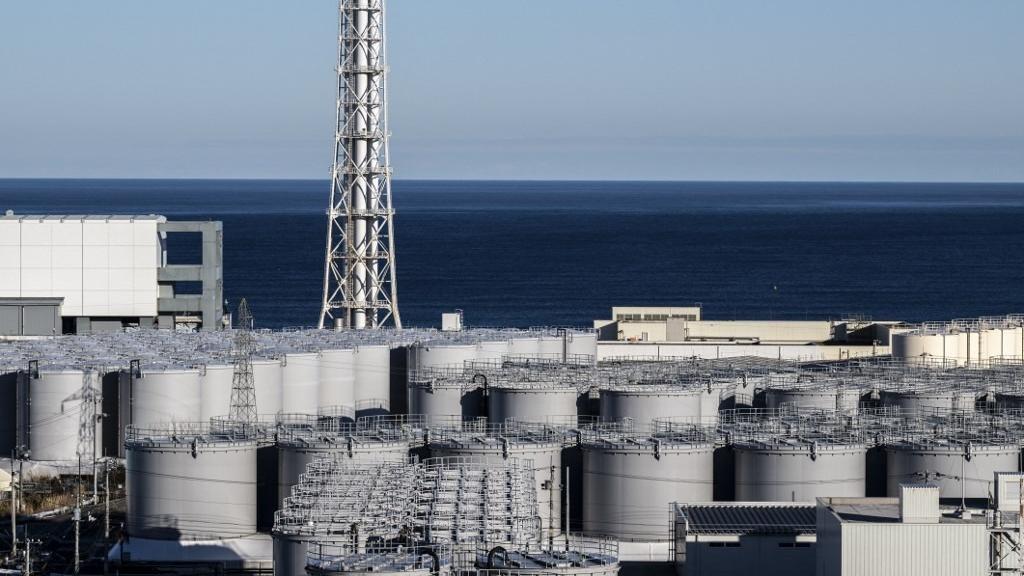 A general view shows storage tanks for contaminated water at the Tokyo Electric Power Company's (TEPCO) Fukushima Daiichi nuclear power plant, in Okuma of Fukushima prefecture, on Jan 20, 2023. (PHOTO / AFP)
A general view shows storage tanks for contaminated water at the Tokyo Electric Power Company's (TEPCO) Fukushima Daiichi nuclear power plant, in Okuma of Fukushima prefecture, on Jan 20, 2023. (PHOTO / AFP)
A deep-seated distrust of the Japanese government and Tokyo Electric Power Company (TEPCO) is behind the public anxiety sparked by Japan’s plans to discharge nuclear-contaminated water into the ocean, political groups and experts said.
“TEPCO’s long concealment of the fact that many nuclides exceeding the specified value could not be removed (from the wastewater at the crippled Fukushima nuclear power plant) has resulted in a significant loss of credibility. It is difficult to say that the clarification of the actual state of contaminated water has been accepted both domestically and internationally,” the Social Democratic Party of Japan’s national union and the party’s Fukushima prefectural union said in a recent statement.
Discharging nuclear-contaminated water into the sea is not the only option for the Japanese government and TEPCO to address the problem
“The hydrogen and nuclear explosions at the Fukushima nuclear power plant caused an unprecedented core meltdown, and all kinds of nuclides, concrete, etc, were mixed together with groundwater and cooling water, and became a large amount of contaminated water,” the statement said, referring to the March 2011 disaster at the power plant that came in the wake of a powerful earthquake and tsunami.
READ MORE: Fukushima plan a nuclear threat to Asia-Pacific
The Fukushima water “must be considered fundamentally different from radioactive emissions from existing nuclear power plants under controlled conditions”, it said.
There are more than 60 nuclides in the contaminated Fukushima water, “and besides tritium, there are nuclides that cannot be removed by the Advanced Liquid Processing System,” the statement said, alluding to TEPCO’s treatment process for the nuclear wastewater.
Japanese and foreign experts have proposed various alternatives for disposal of the contaminated water. There are various realistic proposals other than ocean discharge, such as concrete solidification and giant-tank-storage proposals. TEPCO has a site where additional tanks could be installed, the statement noted.
“Instead of unilaterally deciding that there is no space for additional tanks … we should spend more time seriously considering alternatives,” the SDP said.
Shunji Matsuoka, a professor at the Graduate School of Asia-Pacific Studies at Waseda University, said the Japanese government and TEPCO — the nuclear power plant’s operator — should have held dialogues with diverse group of local residents and experts right from the stage of considering a wide range of options in regard to handling the wastewater.
Matsuoka told The Asahi Shimbun newspaper that there are scientifically reasonable methods other than ocean discharge. Evaporating the liquid through atmospheric release, which has been proven effective overseas, is among such options.
Naoya Sekiya, associate professor at the Center for Integrated Disaster Information Research at the University of Tokyo, conducted two surveys in 2017 and 2022, involving 3,000 people from 10 countries and regions, including Japan, China and the Republic of Korea, to investigate their nuclear disaster awareness.
The survey found that in 2022, nearly 60 percent of respondents in ROK and slightly over 50 percent in China expressed concerns about the safety of their seafood due to the impact of radioactive substances. Additionally, approximately 80 percent of respondents in ROK and nearly 60 percent in China felt uneasy about seafood products originating from Fukushima prefecture.
The lack of sufficient information dissemination has been a significant contributing factor to public anxiety, Sekiya told The Asahi Shimbun. The Japanese government should have been more proactive in sharing information, especially with neighboring countries where strong anxiety persists, he said.
Zhang Yulai, vice-president of the Japan Institute at China’s Nankai University, said there is no precedent in human history for the large-scale release of contaminated water resulting from a nuclear accident, and that there is significant controversy surrounding the Fukushima water’s safety and the scientific implications of the planned discharge.
The butterfly effect and unknown consequences of the discharge plan are difficult to verify with current technologies, he added
“As the main party involved in the Fukushima nuclear accident, Tokyo Electric Power Company has a history of integrity issues and has been plagued with numerous problems since the accident on March 11, 2011. In addition, the credibility of the Japanese government has rapidly declined in recent years,” Zhang said.
He added that the authority and credibility of international organizations have also come into question, “especially as the US has treated international organizations as manipulable puppets”.
Discharging nuclear-contaminated water into the sea is not the only option for the Japanese government and TEPCO to address the problem.
“Compared to methods such as injection into the ground, evaporation into the atmosphere, and solidification and burial, discharging nuclear-contaminated water into the sea is the most convenient option at the lowest cost. However, in the long run, it will become the biggest liability for the Japanese government and TEPCO,” Zhang said.
READ MORE: China slams Japan's Fukushima water discharge plan
“The best solution to alleviate people’s anxiety is to explore better alternatives instead of merely opting for the easiest way out.”
In accordance with the principles of being responsible for the global environment and safeguarding the common interests of all humanity, Japan should abandon the idea of discharging nuclear-contaminated water into the sea and actively explore other options, Zhang said.
To do so, Japan should openly share relevant information and adopt a more transparent, fair and scientific approach, and even explore cooperation with other countries to collectively resolve this issue, he said.
Contact the writer at jiangxueqing@chinadaily.com.cn


